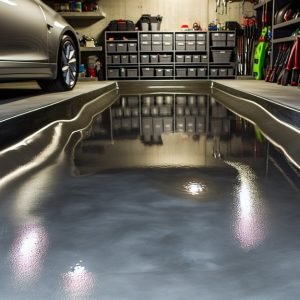Last Updated on May 21, 2025 by teamobn
DIY builders need materials that perform well and look great. Soapstone countertops resist heat and stains naturally. The soft surface blends minor scratches into the pattern. You’ll find it easy to cut and shape with basic tools. Simple maintenance keeps the stone looking fresh for years.
Contents
What Makes Soapstone Unique?
Soapstone forms from talc-rich metamorphic rock. Its smooth, velvety feel comes from high talc content. You can see subtle veins that add character. It rarely chips because it’s softer than granite or quartz.
The stone resists heat naturally. You can place hot pans directly on its surface without worry. Its dense structure repels liquids and acids. Stains are unlikely since it lacks pores that trap spills.
Over time soapstone darkens into a deep charcoal patina. You can refresh the look by rubbing mineral oil into the surface. Minor scratches blend in and add to its worn-in charm. Each slab develops a unique story as it ages.
Benefits for DIY Installations
Soapstone offers DIYers forgiving workability and minimal finish work. You’ll save time and avoid specialized labor.
Low-Maintenance Durability
Soapstone’s dense structure resists stains and bacterial growth. You’re less likely to battle discoloration or mold over time. Routine cleaning with mild soap and water keeps it pristine. Occasional mineral-oil applications restore its even tone. This ease of care means you can focus on your project instead of long-term upkeep.
Heat and Chemical Resistance
You can set hot pots and pans on soapstone without damage. Acids from citrus or wine won’t etch its surface. It maintains structural integrity under extreme kitchen conditions. That reliability gives you peace of mind when working on your own. It’s a practical choice for cooking-focused spaces.
Ease of Handling and Shaping
Soapstone cuts more cleanly than harder stones. You can use standard wet saws and grinders with less wear. Its softer nature reduces dust and tool strain. That lowers your equipment costs and clean-up time. You’ll feel confident making precise cuts without expert skill.
Consistent Slab Thickness
Commercial soapstone slabs arrive at uniform thickness. You’ll avoid uneven seams and awkward fitting. This consistency simplifies dry-fitting and leveling. It reduces frustration during installation. Your countertop will sit flush on cabinets and substrates.
Natural Beauty Evolution
Your countertop gains a rich, dark patina over months of use. Each scratch or mark adds character instead of detracting. You control the look by choosing oiling frequency. The result feels custom and lived-in. It complements both rustic and modern kitchen designs.
Installing Soapstone Countertops at Home
Soapstone countertops enhance the aesthetic of your kitchen. Save money by following these DIY installation steps:
Tools and Techniques for Cutting and Shaping
You don’t need exotic equipment to work soapstone. Basic stone-cutting tools deliver precise results.
- Diamond-tipped wet saw for straight, smooth cuts
- Angle grinder with continuous-rim stone blade for curves
- Circular saw fitted with a continuous-rim masonry blade
- Carbide scoring knife for light scoring before breaks
- Fine-grit sanding pads or stones for edge smoothing
- Clamps and straightedges to guide accurate cuts

Preparing Cabinets and Substrates
Accurate preparation prevents issues during countertop installation. Proper support ensures lasting performance.
- Verify cabinets are level with a long spirit level
- Reinforce substrate with ¾″ exterior-grade plywood
- Install mid-span supports under cabinet spans over 24″
- Allow ¼″ expansion gap at walls for slab movement
- Dry-fit foam or shims to check slab alignment
- Mark overhang dimensions to guide cutting
Cutting, Fitting, and Seaming Slabs
Taking time to fit slabs correctly yields seamless joins. Careful layout reduces material waste.
- Measure and mark cut lines using a square and pencil
- Use a straightedge clamp guide for wet-saw cuts
- Dry-fit cut pieces on cabinets to confirm dimensions
- Clean seam edges and apply two-part epoxy filler
- Align slabs and press firmly into the wet filler
- Remove excess filler before it cures for tidy seams
Securing Slabs with Adhesives
Choosing proper adhesive prevents shifting and gaps. Slow-setting products give you time to adjust.
- Select a high-strength, non-sag silicone adhesive
- Apply ¼″ beads along cabinet face frames
- Lower slab gently and press into the adhesive bed
- Use temporary shims to hold slab level during cure
- Wipe away excess sealant with a damp cloth
- Allow full cure time per manufacturer instructions
Finishing Edge Profiles and Sealants
Edge details complete your countertop’s look and performance. Sealants protect the stone and enhance patina.
- Choose router bit profiles like eased, bullnose, or ogee
- Use a solid-base router with light passes to shape edges
- Sand profiles progressively with 120 to 220 grit pads
- Apply mineral oil or stone conditioner evenly across edges
- Buff with a clean cloth to remove excess and highlight sheen
- Reapply oil quarterly to maintain uniform color development
Routine Cleaning and Care Tips
Keeping a simple care routine protects your investment. Regular cleaning prevents stains and enhances patina development.
Daily Wipe-Down
A daily wipe-down removes crumbs and spills before they settle. Use a soft microfiber cloth dampened with warm water to prevent scratches. Dry the surface with a clean lint-free towel to avoid water spots. Skip harsh chemical cleaners that strip the stone’s natural oils and dull its patina. It takes just a minute after cooking or food prep. You’ll reduce rubbing later with deeper cleans.
Weekly Deep Clean
Once a week, give your countertop a thorough scrub. Mix a drop of pH-neutral soap into warm water. Gently mop the surface with a soft sponge or cloth. Rinse well to remove any soap residue and dry completely. Check corners and seams for trapped dirt. This deeper clean keeps grime from building up and preserves the stone’s natural charm.
Stain Spot Treatment
Address spills right away to stop staining. Blot liquid with a soft cloth rather than wiping it around. For stubborn spots, make a paste of baking soda and water. Apply the paste to the stain and cover with plastic wrap for a few hours. Gently rinse and dry the area when the paste lifts the stain. Repeat only if needed to protect the stone’s finish.
Mineral Oil Maintenance
Mineral oil brings out soapstone’s rich color and patina. Pour a small amount onto a clean cloth and rub it in circular motions. Let the oil soak in for about 30 minutes. Wipe away any excess oil with a dry cloth. Repeat this process every three to six months. You’ll refresh the countertop’s depth and minimize scratch visibility.
Scratch Camouflage
Minor scratches add character but you can soften their look. Rub the scratched area with 0000-grade steel wool in gentle circular strokes. Clean the dust away with a damp cloth and dry thoroughly. Apply mineral oil afterward to even out the tone. Deeper scratches can be lightly sanded with fine-grit pads before oiling. This process blends imperfections into the stone’s pattern.
Avoiding Damage
Prevent damage by using cutting boards and trivets. Lift heavy items instead of dragging them across the surface. Avoid abrasive pads or cleaners with acids or bleach. Keep sharp tools away from exposed edges. If a hot pan must rest on the countertop, use a trivet first. Small steps can save you major repairs down the road.
Routine care keeps your soapstone countertops in top condition. You’ll protect their beauty and extend their life. Minor issues stay minor with early attention. A simple cleaning routine builds your confidence as a DIY installer. Your countertop will grow richer and more character-filled over the years of use.
Design Inspiration and Color Variations
Soapstone countertops blend natural beauty and practical design. You’ll find color options that suit any style. Their patina evolves with use. Select a shade that works with your theme. Let each variation inspire your next kitchen upgrade.
Classic Charcoal Elegance
Soapstone slabs often appear in deep charcoal tones that ground a space in timeless style. The dark surface contrasts beautifully with light cabinetry and fixtures. You’ll create a bold focal point that feels sophisticated and cozy.
This classic choice works in both modern and traditional kitchens. Add warm under-cabinet lighting to reveal subtle veining and texture in low-light settings. This simple touch brings out the stone’s depth.
Warm Earthy Tones
Some soapstone comes in rich olive and brown shades that echo natural stone outdoors. These warm hues add an organic feel and pair well with wood cabinets. You’ll enhance a farmhouse or rustic kitchen with tones that reflect sandy beaches and forest floors.
Natural imperfections and small flecks in the stone add character and depth. Consider open shelving to showcase the countertop’s earthy warmth and keep the space feeling airy.
Soft Gray and Blue Hues
Lighter slabs feature whispery gray and pale blue veins for a coastal vibe. The subtle contrast keeps the look airy and relaxed. You’re free to pair it with white or navy cabinetry for crisp style.
This palette works in beach houses and minimalist designs. Metal accents like brushed nickel add a cool shine against the stone’s soft tones, creating an understated yet polished appearance.
Bold Veining Statements
Select soapstone with strong white or gold veins to make a modern impact. Veining patterns vary slab to slab so no two countertops match exactly. You’ll enjoy a work surface that feels like an art installation. Use simple hardware and light walls to let the slab shine. This option works best when you want a showstopping centerpiece that commands attention in any kitchen.
Contrasting Edge Details
Highlight your countertop with edges cut in a lighter complementary stone. A thin inset of marble or quartz around the perimeter adds subtle luxury. You can also use a hand-chiseled edge that showcases the soapstone’s raw nature and craftsmanship. These details elevate a simple slab to a bespoke feature. Mix polished and honed finishes for gentle contrast that feels custom.
Mixed Material Pairings
Pair soapstone with reclaimed wood or concrete islands for layered texture. You’re free to combine cool stone with warm wood to balance visual weight. Consider a floating wood shelf that aligns with the countertop edge for seamless flow. This pairing bridges old and new styles in one cohesive look. It’s a creative way to bring contrasting elements together without tension.
Conclusion
Installing soapstone countertops blends beauty and practicality in any kitchen. You’ll appreciate how easy they are to cut, shape, and install yourself. The material’s natural durability and evolving patina ensure your work looks better with time. With simple cleaning and oiling, you’re ready to enjoy a stunning surface that lasts.
When you need more countertop ideas for your kitchen, check out our guide on kitchen countertops.






